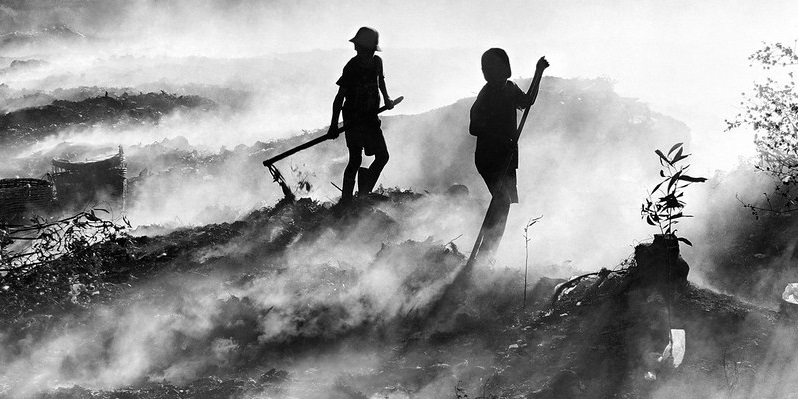Agricultural child labour: A persistent global issue seemingly immune to eradication attempts
With recent estimates reporting an increase in instances of child labour, IGDC PhD Researcher Charlotte Bagshaw explores in this blog whether, more than twenty years on, are we any further forward to eliminating child labour from agricultural production?

Charlotte Bagshaw, IGDC PhD Researcher, shares with us the current situation around child labour in agriculture and why this remains a key issue.
Child labour is not a social issue confined to the history books, and it currently affects the lives of an estimated 160 million children (ILO,2020). Most child labourers, around 60%, are employed within agriculture (ILO, ND), producing goods and materials for many of our well-known products. Many of our household staples like tea, coffee, cotton, sugar, cocoa, and tobacco are crops where children regularly engage with the planting, growing and harvesting stages of production. The buying practices of consumers, frequently in the West, are linked to agricultural practices in the Global South- typically sub-Saharan Africa, by complex global supply chains. The buying and selling practices of these chains make the already difficult task of child labour regulation all that more complicated.
Agriculture is a hazardous occupation for children and adults alike, and many aspects of agricultural work undertaken by children are considered hazardous forms of child labour. Hazardous child labour is regarded as a distinct form of child labour by the international community and civil society, and it is typically viewed as an issue for immediate eradication. The manual nature of production, long hours, and handling of dangerous pesticides and fertilisers means that removing children from this environment is at the heart of many global campaigns (ILO, ND).
Over the last two decades, there have been numerous eradication attempts, including media campaigns, National Plans of Action (NAPS), cultural (re) education programmes, consumer awareness schemes and social corporate responsibility programmes. These tactics have attracted millions in sponsorship and funding, and many have risen to international prominence and fame. Alongside this action, global governance systems and prominent regulatory actors like the ILO have established numerous international conventions in an attempt to eradicate child labour. Notably, Convention C138 - Minimum Age Convention, 1973 (No. 138) (ilo.org) and Convention C182 - Worst Forms of Child Labour Convention, 1999 (No. 182) (ilo.org). Both Conventions have been supported by international conferences and global commitments from government leaders, corporate bodies and NGOs. Despite this and sustained collective action aimed at eradicating both hazardous and non-hazardous child labour, children across the globe still regularly engage in the practice.
Why then does child labour remain?
The answer is far from simple, and it is impossible to give one single cause. A complex mixture of social attitudes, rampant poverty, household dependency, alternative constructions of childhood, production cycles and poor labour law enforcement collectively help to explain the continued existence of child labour globally and more specifically within African agriculture (See work by Hazarika and Sarangi, 2008; Makwinja, 2010; Kaime, 2011; Maganga., 2012; Fisher and Kandiwa, 2014). Critically to truly understand child labour, we must consider it within the specific context in which it occurs, as it is shaped by the production systems and socio-cultural context surrounding it. To further complicate the issue, agricultural child labour is considered a complicated form to eradicate, as it is historically and commonly under-regulated and legislated against, formed from a migrant workforce and embedded within rural household survival and practices. Indicative of global child labour, rural poverty often means that parents require the economic contributions of children to meet the household's needs, including food and education. Many producers and families are trapped within poverty cycles due to poor export values and systemic labour and wage issues (Child labour - (fairtrade.net), N.D). Such issues affect entire communities, families, and children typically found working on plantations. Faced with the choice of starvation or work, most parents and children, who are not agentless beings, choose the latter.
The plethora of programmes, projects and action launched against agricultural child labour have each attempted to eradicate the issue. Some have focused on poverty alleviation and primary education provision (eg. The SNAP Malawi project Going child labour free in Malawi (ilo.org)). Some have challenged the buying practices of consumers and lobbied for boycotts and industry change (eg ICI’s Cocoa Initiative, Child labour in cocoa | ICI Cocoa Initiative and Fairtrade international standards and certification scheme Child labour - (fairtrade.net)). Others are the result of social corporate responsibility programmes and the creation of industry guidelines (eg Tony’s Open Chain child labor in the chocolate industry - Tony's Chocolonely (tonyschocolonely.com) or Nestle’s income accelerator programme Nestlé announces innovative plan to tackle child labor risks, increase farmer income and achieve full traceability in cocoa (nestle.co.uk)). Despite this variety, agricultural child labour remains.
To truly understand child labour's apparent immunity to action, it is essential that we first establish and map the action that has occurred on a case-by-case basis- examining how the issue has been addressed, framed and conceptualised. Only then can we progress our knowledge of agricultural child labour and the many attempts to curb the practice.
Feature Image: "Child Labour Photo Contest 2012_Fourth Prize" by ILO in Asia and the Pacific is licensed under CC BY-NC-ND 2.0.
| Featured Researcher | Charlotte Bagshaw |
|---|---|
|
|
Charlotte first became interested in global development during her undergraduate studies. From her BA in Human Geography, Charlotte completed her MA in Global Development. She finds the effects of global connectivity and broadening societal awareness of global issues fascinating. Charlotte plans to continue studying child labour as feels it is a complex and contested global challenge that needs further investigation |
Contact us
Interdisciplinary Global Development Centre
igdc@york.ac.uk
01904 323716
Department of Politics and International Relations, University of York, Heslington, York, YO10 5DD, UK
Twitter
Contact us
Interdisciplinary Global Development Centre
igdc@york.ac.uk
01904 323716
Department of Politics and International Relations, University of York, Heslington, York, YO10 5DD, UK
Twitter
